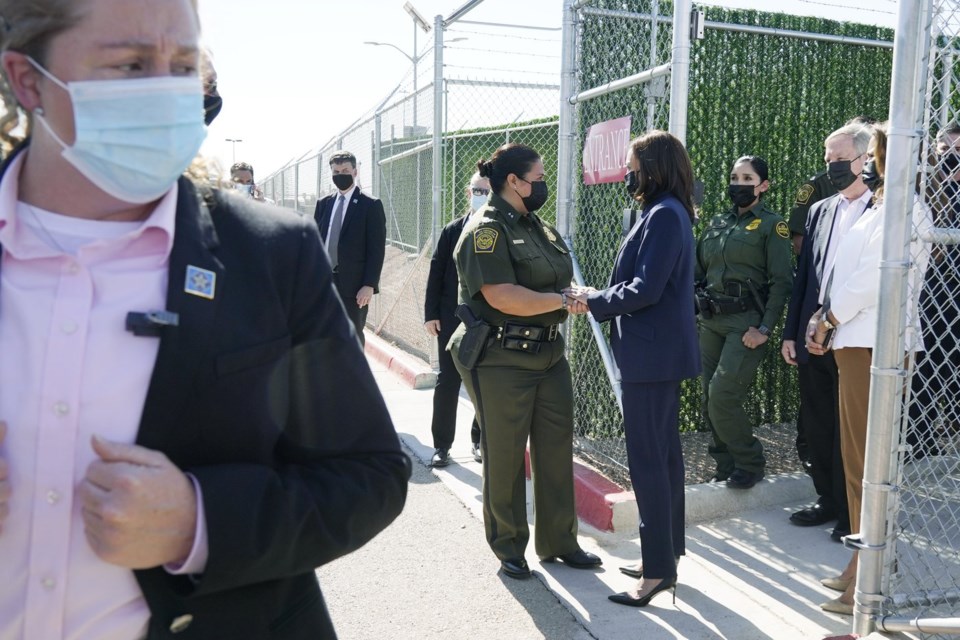WASHINGTON (AP) — As thousands of immigrants approached the U.S. border in early 2021, President Joe Biden tapped his second-in-command to address the influx. The decision has exposed Vice President to one of her biggest political liabilities.
±á˛ą°ů°ůľ±˛ő’ was to tackle the “root causes” of migration from three Central American nations — El Salvador, Guatemala and Honduras — that were responsible for a significant share of border rossers. The vice president took a long-term approach to an immediate problem, helping convince multinational corporations and Latin American businesses to invest in the region. That, she argued, would create jobs and give locals more reasons to stay at home rather than take the arduous trek north.
Migration from those three Central American countries did gradually drop, though experts say it’s unlikely that ±á˛ą°ů°ůľ±˛ő’ plan was a major factor. The decrease was swamped by a surge in migration from elsewhere in Latin America, and Republicans now blame Harris for all the myriad problems that plagued the U.S. southern border during the administration’s term.
Here are some things to know about ±á˛ą°ů°ůľ±˛ő’ record on migration as vice president.
She was never the "border czar"
The GOP and even some media outlets called Harris the “border czar” after she got her assignment from Biden, but that was never her actual job. She had no special responsibilities at the border. Those involved in the hottest issue there — negotiations over whether to continue former President Donald Trump’s pandemic immigration policy known as Title 42 — say the vice president was not involved in that debate.
Biden tasked Harris with working with the Central American nations “to accept returnees and enhance migration enforcement at their borders.” Some critics contend she dodged that assignment and mainly focused on long-term investments.
Harris took two trips to Mexico and Central America in 2021 and 2022, including a visit to Guatemala in June 2021 where she told would-be migrants “ ” to the U.S. During that trip she also she had not been to the U.S.-Mexico border during an interview with NBC’s Lester Holt by saying she hadn't “been to Europe. And I mean, I don’t … understand the point that you’re making.”
That line became part of Trump’s first ad against Harris, which blames her for hundreds of thousands of deaths from fentanyl and crimes committed by people who entered the country illegally.
Harris has defended her record. Her campaign began running a television ad on Friday that said Harris would “hire thousands more border agents and crack down on fentanyl and human trafficking” as president. Democrats have also blasted Trump for helping tank a bipartisan immigration bill earlier this year that would have increased funding for border security, including new Customs and Border Protection personnel.
Harris focused on business investments
The vice president’s most prominent achievement was tapping into a network of business and nonprofit executives to invest in El Salvador, Guatemala and Honduras, which are known as the Northern Triangle nations.
The work linked multinational companies — like Visa, Nestle and Meta — with smaller nonprofits and Latin American businesses, all of which pledged to increase their investments or bolster their work with at-risk communities.
The Associated Press contacted all of the as participants in ±á˛ą°ů°ůľ±˛ő’ effort. Some, like AgroAmerica, a sustainable food corporation that pledged to invest more than $100 million in six new projects, reported their work had begun and they were on track to meet their investment goals. Others, including Columbia Sportswear Company, said they would likely surpass their goals.
Most companies, however, either declined to comment or did not respond when asked about the work they have done to meet their pledges.
The vice president’s office has said that Harris' outreach has generated more than $5.2 billion in investment promises. In an illustration of how long it takes the promises to translate into concrete spending, the State Department reported that companies have plowed as of June 2024, the bulk of it in Guatemala and Honduras.
Katie Tobin, who worked as the top migration adviser at the National Security Council for three years, credited ±á˛ą°ů°ůľ±˛ő’ focus with spurring investment in reducing these numbers, arguing that Harris “was able to leverage her credibility” and the power of the White House to convince companies to invest in “a risky investment environment.”
“That was very much Kamala Harris,” she added. “I have never seen something like that done before in this space, and it made a real impact.”
Republican Sen. Rick Scott, a critic of the administration on Latin American issues, questioned whether the White House should really be credited for business investments. He argued they would have happened without Harris.
The companies are “not doing it because someone asked them to,” said Scott, who co-founded a major medical company, “they’re doing it because it makes economic sense.”
Did it work?
While the Harris campaign and White House have pointed to statistics that show migration from Northern Triangle countries has dropped substantially since early 2021, there is debate over what is behind the decrease.
Sen. Chris Murphy, a Â鶹´«Ă˝icut Democrat, said Harris and the administration deserve credit for the reduction because their efforts “worked,” adding that ±á˛ą°ů°ůľ±˛ő’ contribution has been overlooked.
Independent analysts, however, said they were skeptical that ±á˛ą°ů°ůľ±˛ő’ approach played much of a role. They said the decrease was likely driven by other regional factors, including the ascension of El Salvador’s new president and his aggressive drive to combat violent crime. His government reported a 70% drop in homicides in 2023.
Julia Gelatt, associate director of the Migration Policy Institute in Washington, said investment can take years to alter migration patterns — if it ever does.
“Even a whole lot of economic development doesn’t curb immigration in the way countries hope it will,” Gelatt said.
Nicholas Riccardi, Chris Megerian And Dan Merica, The Associated Press




